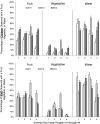Increasing fruit, vegetable and water consumption in summer day camps--3-year findings of the healthy lunchbox challenge
- PMID: 24890189
- PMCID: PMC4165987
- DOI: 10.1093/her/cyu026
Increasing fruit, vegetable and water consumption in summer day camps--3-year findings of the healthy lunchbox challenge
Abstract
The objective of this study was to describe the 3-year outcomes (2011-2013) from the healthy lunchbox challenge (HLC) delivered in the US-based summer day camps (SDC) (8-10 hours day(-1), 10-11 weeks summer(-1), SDC) to increase children and staff bringing fruit, vegetables and water (FVW) each day. A single group pre- with multiple post-test design was used in four large-scale SDCs serving more than 550 children day(-1) (6-12 years). The percentage of foods/beverages brought by children/staff, staff promotion of healthy eating and children's consumption of FVW was assessed via direct observation over 98 days across three summers. For children (3308 observations), fruit and vegetables (>11-16%) increased; no changes were observed for FVW for staff (398 observations). Reductions in unhealthy foods/beverages (e.g. soda/pop and chips) were observed for both children and staff (minus -10% to 38%). Staff role modeling unhealthy eating/drinking initially decreased but increased by 2013. The majority of children who brought fruit/vegetables consumed them. The HLC can influence the foods/beverages brought to SDCs. Enhancements are required to further increase FVW brought and consumed.
© The Author 2014. Published by Oxford University Press. All rights reserved. For permissions, please email: journals.permissions@oup.com.
Figures
References
-
- Carrel AL, Clark RR, Peterson S, et al. School-based fitness changes are lost during the summer vacation. Arch Pediatr Adolesc Med. 2007;161:561–4. - PubMed
-
- Gutin B, Yin Z, Johnson M, et al. Preliminary findings of the effect of a 3-year after-school physical activity intervention on fitness and body fat: The Medical College of Georgia Fitkid Project. Int J Pediatr Obes. 2008;3(Suppl. 1):3–9. - PubMed
-
- Gillis L, McDowell M, Bar-Or O. Relationship between summer vacation weight gain and lack of success in a pediatric weight control program. Eat Behav. 2005;6:137–43. - PubMed
Publication types
MeSH terms
Substances
Grants and funding
LinkOut - more resources
Full Text Sources
Other Literature Sources
Medical


